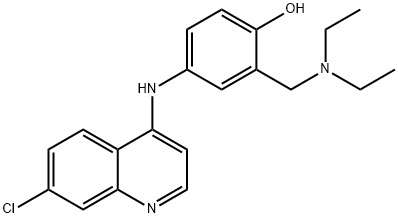
Amodiaquine
- русский язык имя
- английское имяAmodiaquine
- CAS №86-42-0
- CBNumberCB8344720
- ФормулаC20H22ClN3O
- мольный вес355.86
- EINECS201-669-3
- номер MDLMFCD00552927
- файл Mol86-42-0.mol
химическое свойство
| Температура плавления | 208°C |
| Температура кипения | 478.0±45.0 °C(Predicted) |
| плотность | 1.258 |
| температура хранения | -20°C Freezer |
| растворимость | DMSO (Slightly, Sonicated), Methanol (Slightly) |
| форма | Solid |
| пка | 9.43±0.50(Predicted) |
| цвет | Pale Yellow to Light Yellow |
| Справочник по базе данных CAS | 86-42-0(CAS DataBase Reference) |
| Рейтинг продуктов питания EWG | 1 |
| FDA UNII | 220236ED28 |
| Справочник по химии NIST | Amodiaquine(86-42-0) |
| Код УВД | P01BA06 |
| Банк данных об опасных веществах | 86-42-0(Hazardous Substances Data) | |||||||||
| Токсичность | LD50 oral in mouse: 550mg/kg | |||||||||
| NFPA 704: |
|
рисовальное письмо(GHS)
-
рисовальное письмо(GHS)

-
сигнальный язык
предупреждение
-
вредная бумага
H302:Вредно при проглатывании.
-
оператор предупредительных мер
P264:После работы тщательно вымыть кожу.
P270:При использовании продукции не курить, не пить, не принимать пищу.
P301+P312:ПРИ ПРОГЛАТЫВАНИИ: Обратиться за медицинской помощью при плохом самочувствии.
P501:Удалить содержимое/ контейнер на утвержденных станциях утилизации отходов.
Amodiaquine химические свойства, назначение, производство
Описание
Amodiaquine is a prodrug form of the antimalarial compound N-desethyl amodiaquine . It is active against several strains of P. falciparum in vitro (EC50s = 0.23-0.52 nM) and exhibits a synergistic effect when used in combination with N-desethyl amodiaquine. Amodiaquine dose-dependently inhibits development of parasitemia in a mouse model of P. berghei infection.Химические свойства
Cyrstalline SolidИспользование
An antimalarialОпределение
ChEBI: A quinoline having a chloro group at the 7-position and an aryl amino group at the 4-position.Показания
Amodiaquine (Camoquin) is another 4-aminoquinoline derivative whose antimalarial spectrum and adverse reactions are similar to those of chloroquine, although chloroquine-resistant parasites may not be amodiaquine- resistant to the same degree. Prolonged treatment with amodiaquine may result in pigmentation of the palate, nail beds, and skin. There is a 1:2000 risk of agranulocytosis and hepatocellular dysfunction when the drug is used prophylactically.Всемирная организация здравоохранения(ВОЗ)
Amodiaquine, an antimalarial agent related to chloroquine, was introduced over 40 years ago for the treatment and prophylaxis of malaria. The drug was voluntarily withdrawn in the United Kingdom in 1975 for commercial reasons but was subsequently reintroduced in 1985 to meet the medical demand for an antimalarial drug to deal with the rapid spread of chloroquine-resistant falciparum malaria in Asia and Africa. By 1986 a significant number of cases of agranulocytosis associated with prophylactic use, some of which were fatal, had been reported there and it has been estimated that the frequency of this risk is of the order of 1:2,000. Although most cases occurred when amodiaquine had been used in combination with other antimalarials, the major manufacturer decided to withdraw the prophylactic indication worldwide following discussions with experts. Preparations remain available for the treatment of acute attacks of malaria which involves only a short period of exposure to the drug. (Reference: (WHODI) WHO Drug Information, 1, 5, 1987)Фармацевтические приложения
A mono-Mannich-base 4-aminoquinoline, formulated as the dihydrochloride dihydrate or free base for oral administration. It is active against P. falciparum and P. vivax and is more active than chloroquine for the treatment of uncomplicated P. falciparum malaria. Chloroquine-resistant strains may remain susceptible, but resistance to amodiaquine is also spreading in some regions of Africa. The pharmacological properties are similar to those of chloroquine. The terminal elimination halflife is 1–3 weeks. It is rapidly and extensively metabolized to the desethyl derivative which has reduced antiplasmodial activity. Prophylactic use has been abandoned because of agranulocytosis and hepatotoxicity due to formation of a quinoneimine metabolite. A fixed dose combination with artesunate and derivatives (for example, isoquine) with altered metabolism and reduced toxicity is in development.Клиническое использование
Mechanistically, it is very similar to chloroquine and does nothave any advantages over the other 4-aminoquinoline drugs.When used for prophylaxis of malaria, it had a higher incidenceof hepatitis and agranulocytosis than that was chloroquine.There is evidence that the hydroquinone (phenol)amine system readily oxidizes to a quinone imine either autoxidatively and/or metabolically, and this productmay contribute to amodiaquine’s toxicity.Методы очистки
Amodiaquin crystallises from 2-ethoxyethanol or EtOH. [Burckhalter et al. J Am Chem Soc 70 1363 1948, Beilstein 22 III/IV 4647.]Amodiaquine запасные части и сырье
Amodiaquine поставщик
| поставщик | телефон | страна | номенклатура продукции | благоприятные условия |
|---|---|---|---|---|
| +86-0371-55170693 +86-19937530512 |
China | 21632 | 55 | |
| +86-86-5926051114 +8618959220845 |
China | 6383 | 58 | |
| +8618523575427 | China | 49732 | 58 | |
| +86-0371-86658258 +8613203830695 |
China | 29809 | 58 | |
| 86-512-58389969 | CHINA | 111 | 58 | |
| +86-13806087780 | China | 17365 | 58 | |
| +1-781-999-5354 +1-00000000000 |
United States | 32161 | 58 | |
| +86-0551-65418671 +8618949823763 |
China | 34563 | 58 | |
| 571-88938639 +8617705817739 |
China | 52849 | 58 | |
| +86-89586680 +86-13289823923 |
China | 8670 | 58 |